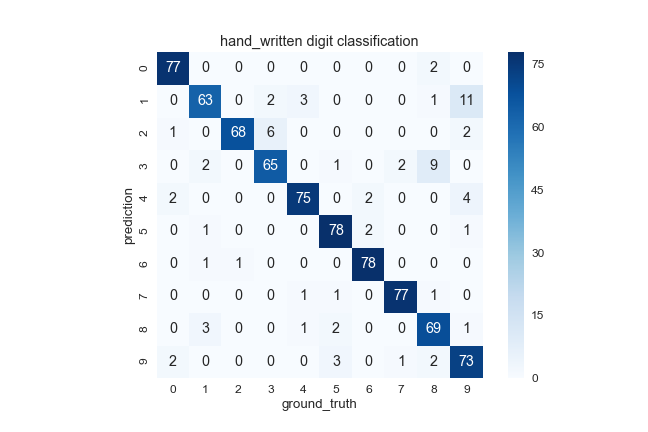scikit-learn: pythonの機械学習ライブラリ。deep learningそのものの構築はないけど、評価メトリクスやハイパーパラメータ探索に便利なAPIがあります。

インストール
$ pip install scikit-learn
1. 学習モデルの作成
- 機械学習モデルのinstance作成
- 学習(fit)、ハイパーパラメータ決定
- 予測(predict)、評価
lasso.py
from sklearn.tree import DecisionTreeClassifier
from sklearn.model_selection import GridSearchCV
from sklearn.metrics import accuracy_score
# 0. データ読み込み
from sklearn.datasets import load_iris
iris = load_iris()
X_train, X_test = iris.data[:120], iris.data[120:]
y_train, y_test = iris.target[:120], iris.target[120:]
# 1. 機械学習モデルのinstance作成
model = DecisionTreeClassifier(criterion="entropy")
# 2. 学習(fit)、ハイパーパラメータ決定
clf = GridSearchCV(model, {'max_depth': [2, 3, 4, 5, 6]}, verbose=1)
clf.fit(X_train, y_train)
print clf.best_params_, clf.best_score_
# 3. 予測(predict)、評価
pred = clf.predict(X_test)
print accuracy_score(y_true, y_pred)
2. 学習結果の評価
precision, recall, f1-score の評価
class-labelの数に偏りがあるときに有用
from sklearn.metrics import classification_report
pred = clf.predict(X_test)
print classification_report(y_test, pred)
# precision recall f1-score support
#
# 0 0.94 0.97 0.96 79
# 1 0.90 0.79 0.84 80
# 2 0.99 0.88 0.93 77
# 3 0.89 0.82 0.86 79
# 4 0.94 0.90 0.92 83
# 5 0.92 0.95 0.93 82
# 6 0.95 0.97 0.96 80
# 7 0.96 0.96 0.96 80
# 8 0.82 0.91 0.86 76
# 9 0.79 0.90 0.84 81
#
# avg / total 0.91 0.91 0.91 797
混同行列の出力
class-label種類が3以上のタスクの評価に有用
from sklearn.metrics import confusion_matrix
import pandas as pd
import seaborn as sns
import matplotlib.pyplot as plt
pred = clf.predict(X_test)
conf_mat = confusion_matrix(y_test, pred)
print conf_mat
# [[77 0 0 0 0 0 0 0 2 0]
# [ 0 63 0 2 3 0 0 0 1 11]
# [ 1 0 68 6 0 0 0 0 0 2]
# [ 0 2 0 65 0 1 0 2 9 0]
# [ 2 0 0 0 75 0 2 0 0 4]
# [ 0 1 0 0 0 78 2 0 0 1]
# [ 0 1 1 0 0 0 78 0 0 0]
# [ 0 0 0 0 1 1 0 77 1 0]
# [ 0 3 0 0 1 2 0 0 69 1]
# [ 2 0 0 0 0 3 0 1 2 73]]
# seaborn.heatmap を使ってプロットする
index = list("0123456789")
columns = list("0123456789")
df = pd.DataFrame(conf_mat, index=index, columns=columns)
fig = plt.figure(figsize = (7,7))
sns.heatmap(df, annot=True, square=True, fmt='.0f', cmap="Blues")
plt.title('hand_written digit classification')
plt.xlabel('ground_truth')
plt.ylabel('prediction')
fig.savefig("conf_mat.png")
決定木のプロット
import pydotplus
dot_data = tree.export_graphviz(clf, out_file=None,
feature_names=iris.feature_names,
class_names=iris.target_names,
filled=True, rounded=True,
special_characters=True)
graph = pydotplus.graph_from_dot_data(dot_data)
graph.write_png('iris_tree.png')
3. その他
学習モデルの保存、読み込み
import pickle
pickle.dump(clf, open("model.pkl", "wb"))
clf = pickle.load(open("model.pkl", "rb"))
# sklearnのjoblibを使用した場合(y__samaさんのコメント参照)
from sklearn.externals import joblib
joblib.dump(clf, 'model.pkl')
clf = joblib.load('model.pkl')
サンプルデータセットの読み込み [sklearn.datasets]
from sklearn import datasets
# 3品種のアヤメのデータセット(分類)
# 150samples x 4features
iris = datasets.load_iris()
# 手書き数字のデータセット(分類)
# 1794samples x 64features
digits = datasets.load_digits()
# 地域別のボストン市の住宅価格(回帰)
# 506samples x 14features
boston = datasets.load_boston()
# 糖尿病患者の1年後の疾患進行状況(回帰)
# 442samples x 10features
diabetes = datasets.load_diabetes()
# 中国の写真。shape==(427, 640, 3)
im = datasets.load_sample_image('china.jpg')

